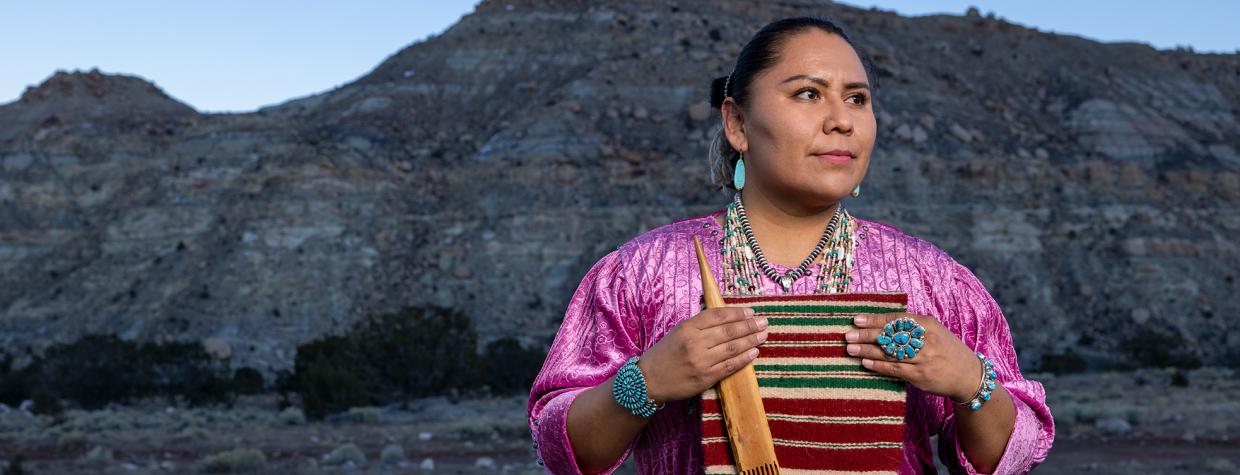It was a warm fall day when the afternoon bell rang at T’iis Nazbas Community School. Another school day had ended. Eager to leave the classroom, I swung my backpack over my shoulders and wiggled into its straps. While other kids hopped onto buses that shuttled them home and others made a short walk to their dorms, I was lucky: I got to spend the rest of the day with my grandmother — whom my family and I called Shimá, meaning “my mother” in Diné.
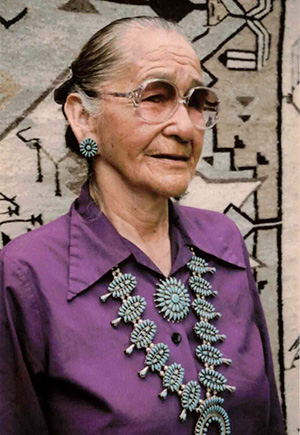
Shimá often looked after me after school. Both of my parents made long commutes to work on and off the rez. They awoke early in the morning, got ready for work and drove into the sunrise on U.S. Route 64 into New Mexico.
My grandmother lived just behind the boarding school, at the brink of the Carrizo Mountains. It was there that she raised her herd of sheep and goats and learned to weave as a young woman determined to learn what others hesitated to teach her.
On that day, I walked past the boarding school cafeteria and up the small hill that led to Shimá’s home. When I reached the cattle guard atop the hill, I could see her roof. I watched the house intently, looking for signs that would tell me what my grandmother was up to that day. Passing through the gate, I could almost taste the fresh tortillas and warm butter that often awaited me. Shimá always had a snack for me, plus a chore or adventure to keep me busy.
As I inched closer, I could see through the open front door, and there Shimá was, moving about the house, her skirt swaying from left to right. What was she doing? What did she make? I wondered. I reached the front step and saw something new. Next to her bed was a small Navajo weaving loom.Shimá warped it for me, and I dropped my backpack and knelt in front of it. I studied it and touched it with my small hands, in disbelief as she uttered, in Navajo, words I wouldn’t soon forget: “It’s yours. It’s time for you to learn to weave.”
Before becoming a storyteller and writer, I was a weaver. And that was the day I learned to create. It was the day I became a fifth-generation Navajo rug weaver and a participant in a tradition that now is six generations old. I come from a small place my family knows as Goat Springs, Arizona, where livestock are known to go for fresh water. Goat Springs sits in the better-known town of Teec Nos Pos, named for its many cottonwood trees. It is where my family hails from — and continues Shimá’s legacy.
Here, my family of artists have, in one way or another, taken Shimá’s teachings, made them their own and carried them on. But it was only recently that I began to think about how, even in times like these, we carry on the traditions of our ancestors. It’s been just over 25 years since I first learned to weave, and I can remember the day as if it were yesterday, but until now, I could not recall how other artists in my family became part of this legacy. How did we get so lucky to have a teacher like Shimá? When did it all start? What exactly is this tradition we are fortunate enough to be a part of?
Late last year, I decided to learn more about the legacy of my late grandmother, so I visited the person I believe knew her best: my uncle Roy Kady, a well-known fiber artist who lives at our family homestead in Goat Springs and continues to care for the family livestock. He was Shimá’s protégé, but most importantly, he is her baby, the youngest of her six children, and was her main caregiver as she entered old age.
I learned that Shimá, whose full name was Mary Kady Clah, had a special relationship with weaving. Being one of two daughters of the great Hastiin Gonna Yé˛é˛ Biye’ Kady Wolyéhígíí and Elizabeth Kady, Shimá was taught how to be the ultimate Navajo woman. From her mother, she learned to take care of a home and family; from her father, she learned to care for livestock and be a farmer and herbalist. Both wanted her to learn the culture and traditions of the people and carry them on. Her mother worked hard to keep Shimá from weaving, fearing that it would distract her from learning what she thought was more important.
“They wanted her to not become preoccupied with [weaving] and wanted her to herd sheep,” Roy says. “They would sell their weavings to the trading post, and back then, they even used to measure it, so if you were off — even by colors, by evenness — then they would deduct whatever and not give you the full amount that you would normally get.”
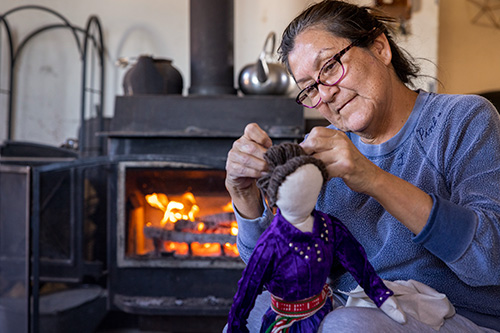
But Shimá was determined. She watched her mother weave, and when her mother stepped away from the loom, Shimá would sneak over, weave a few rows and undo what she had woven, just to practice. She’d also steal bits of yarn, hoping to use them to weave her own rug. Once she had scraped together enough material, she took the sheep out to graze on a mesa west of the family homestead, found the perfect juniper and used it to set up her own loom. The many hours spent watching her mother warp a loom paid off. Shimá looked forward to taking the sheep out in the days after, and she worked on her rug a little at a time. She was nearly halfway done when her mother told her to take the sheep in a different direction to graze. It was days before she returned to her loom, and when she did, she found it eaten and disheveled — small creatures had gotten to it. She shared the story with her mother, who eventually gave in and taught Shimá to weave. Thus began Shimá’s legacy.
When Shimá became a mother, she continued to weave to support her family and for her own enjoyment. When her children were old enough, she began to teach them. My mother, Gloria Clahchischiligi, the oldest daughter, learned to weave when she was in fourth grade but was sent to boarding school and lost touch with weaving. She tried again in junior high but found her niche in crocheting, something she’d learned from the dorm aides in boarding school. Then, it was time for my aunt Vera Clah to learn.
Shimá taught Vera to weave and showed her how to make a rug with a simple design. When she finished it, Shimá wrapped it in a Blue Bird flour sack and the two walked down to the old Foutz trading post, which sat in a small canyon. Vera sold her rug for $15 and bought one or two clothing items, including a $5 pair of Wranglers. It was then that Vera understood the importance of learning to weave: “My mom said, ‘You need to learn to do this. One day you might rely on it. It might come back and you’ll use it.’ So, I did.” Vera later found her niche in sewing; as a young adult, she often sewed her own clothes because her parents couldn’t afford store-bought clothes. Outside of weaving, Shimá loved to make cloth Navajo dolls that looked like Diné wearing traditional Navajo clothing. Through the dolls, she showed her love for fashion and sewing. My aunt Jennifer Clah says her mother was a bit of a fashionista, adding that she admired the way she dressed and made her dolls look. She says Shimá managed to show the beauty of Diné women, which was why Jennifer chose to continue her mom’s work as a Navajo doll maker.
While my grandmother encouraged her children to learn to weave, she never forced them. She had a strategic way of encouraging others to consider something that would benefit them, and it always worked. And when she saw a teachable moment, she seized it.
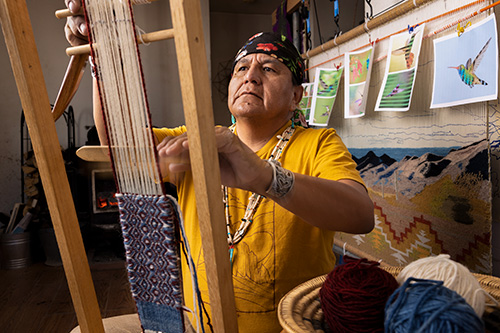
My uncle Roy was about 9 when he learned to weave. Like Shimá, he sat and watched his mother weave, and when she stepped away, he’d sit at her loom, weave a little and try to figure out how she wove her designs. Then, he would undo what he’d woven on her loom. She found out one day and decided to teach him.
“She said, ‘I’m going to set up a loom for you,’ ” Roy recalls. “She wanted me to weave stripes, but I didn’t want to weave it in stripes; I wanted to mimic what she was doing. She let me do it. She didn’t say, ‘Rip it all out because you made a mistake here.’ Maybe that’s what she saw in me.”
It wasn’t until his early 20s that Roy decided to continue Shimá’s legacy. During one of his visits home, Shimá talked him into walking her to my mother’s home, where she had all her best weaving tools stored. While looking through her tools, yarn and weavings, she shared stories about each item and eventually noted that she had little use for them anymore.
Roy shared a little about the work he was doing in Wyoming, working with adults with disabilities who were learning to weave using European looms. He told her of the strong interest others had in Navajo weaving. And she responded in her Shimá way.
“You probably still remember how to weave,” Roy remembers her saying. He confessed that he’d forgotten some things, so she taught him again. Once the loom was up, Roy spent the entire weekend weaving. And when he was about to head back to Wyoming, Shimá left him with a final word. “She said, ‘You weave fast. You’re very progressive,’ ” Roy recalls. “That’s how I started back up.”
Now 57, Roy hasn’t stopped weaving and has evolved as an artist. He’s developed a knack for pictorial weavings, something he says stems from his love for black and white photography. He considers his first pictorial piece his biggest achievement. It’s a rug with a woven image of Shimá in the corral with her flock of sheep. It was a tribute to Shimá but also was a way for Roy to heal after she died in 2013.
“That weaving really set the comfort [level] for me,” he says. “It was after I finished that weaving [that] I thought, I can pretty much do anything in pictorial.”
My uncle has also evolved as a teacher, and he and Shimá have taught generations of weavers in our family. Now, he teaches anyone willing to learn, including community members and others from across the country and around the world.
In addition to weaving, Roy takes pride in being an all-around fiber artist and processes the wool used in his work. He takes care of the Navajo-Churro sheep Shimá left him and turns their wool into yarn. And he teaches others about traditional Navajo herbs, Navajo foods and everything else Shimá taught him, all in an effort to continue my grandmother’s legacy.
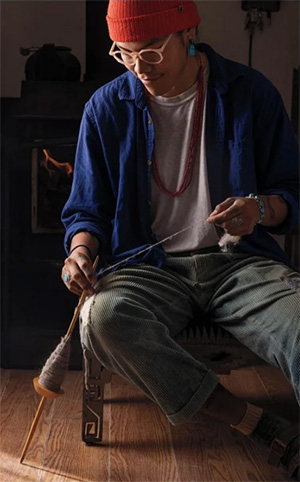
“Whether we consciously remember [teachings] being instilled in us or not, we remember some of these things that we’ve experienced growing up, and it comes back to us,” Roy says. “I hope it continues. I think that’s the main thing about what we share and what we produce. All the students that I have taught, they’ll continue to share it on.”
My nephew Tyrrell Tapaha has taken to weaving and is the lone sixth-generation weaver in the family. Having learned from both Shimá (his great-grandmother) and Roy, he says he feels a need to continue the family legacy. “It’s an injustice to say I don’t think about the responsibility that I have,” Tyrrell says. “This is also my petty cash; it also puts me through school. I’ve been self-sufficient since I left my parents’ place. It’s surprisingly not as common for people my age.”
Like Roy, Tyrrell continues to take what he has learned and use it to sustain himself and carry on the tradition. Most recently, he’s learned the true meaning of “sheep to loom” by herding at the family summer camp atop the Carrizo Mountains and learning to process the wool for his weavings. “There’s no other option in my life that gives me such a sense of fulfillment as this lifestyle does,” he says.
As a daughter, granddaughter, aunt and grandmother, I understand the need to continue a tradition that belongs to not just my grandmother but also those who came before her. And while I now mostly weave words, my comb and loom are always close by, ready to take me back to that warm fall day when Shimá became my teacher and I a part of her legacy.

